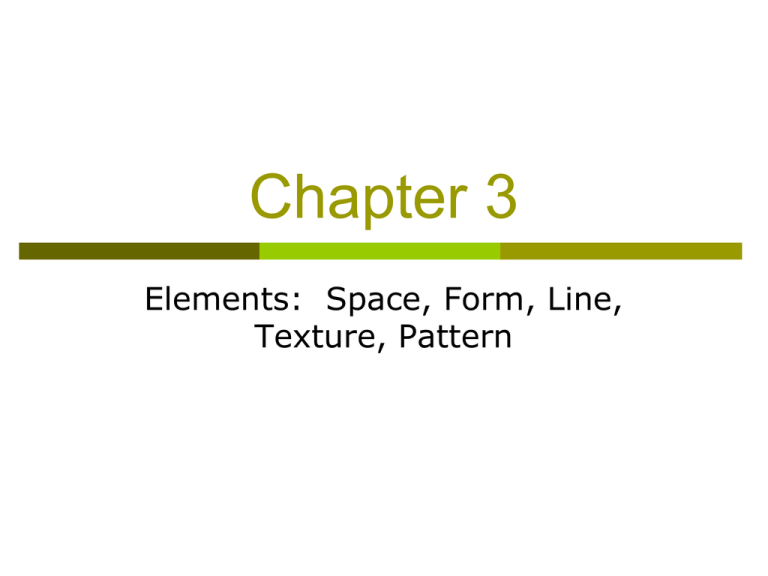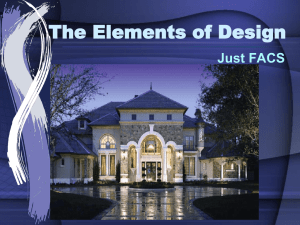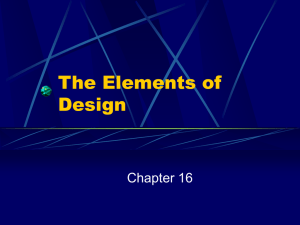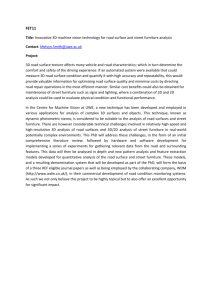Chapter 3
advertisement

Chapter 3 Elements: Space, Form, Line, Texture, Pattern Space Space is the most essential element in Interior Design. It is similar to the blank canvas in which an artist will create a work of art. Space is created by erecting floors, walls and ceilings. What we as designers do with this space represents an enormous commitment. Sensory Perception of space Visual (distant, expansive, close or restrictive) moving freely without bumping into others or objects is desirable. Space is perceived as unsatisfactory if objects are in the way. Cultures can play a role Auditory(sounds reflective or absorbed) Success of a space is related to the acoustical performance some people can screen out unwanted noise may need to accommodate by using various acoustical methods Sensory Perception of space Olfactory(smells from woods, fabrics, leathers) Differs widely by culture (Arab culture) Americans are more likely to try to mask smells Smell is strongly linked to memories Tactile(Sense of touch) tied to visual experiences children tend to touch as a learning experience when body heat from others can be felt in a space, we get a feeling of crowdedness the use of texture in materials and furniture can affect the experience of interior space, either inviting personal involvement or deterring interaction. Spatial Illusion The two most common problems associated with space is the lack of space or an excess of space. A knowledgeable designer can create a “sense” of having more space or create intimacy by the use of other elements of design such as line, form, light, color and texture. To increase the appearance of small space: Use small scale furniture, small patterns, and light textures, Place large furniture items against or parallel to walls to avoid interruptions in open space and division into smaller spaces. Keep furniture and accessories few in number, Expose as much flooring as possible by using wood legs and glass tops rather than skirted furniture, Unify the space by using wall-to-wall flooring, floor to ceiling window treatments and colors, textures, and patterns that blend, Select light, cool colors to expand space Use mirrors Light the perimeter of the room, the ceiling or heavy pieces of furniture to make them appear to “float”. Small Spaces French door help to open space light colored flooring large windows glass table top legs on table and chairs vs. skirts and bases. To create more intimate spaces: Subdivide the space physically and visually by placing furniture perpendicular to the wall to act as room dividers. Choose furniture of varied height to obstruct extended views. Select large scale furniture on solid bases or skirted bases obscuring floor area. Break up expansive area on walls and floors with contrasting colors, textures and patterns Use soft textures to absorb sound and further feelings of privacy and intimacy. Use warm, dark colors Place lighting to create distinct, cohesive spatial units. Illusion of intimate space Subdivide space Use dark colors Low lighting Large scale furniture that covers floor space Space is… among the most important elements of interior design. Unless it is thoughtfully planned, nothing else will ever seem quite right. Shape and Form Shape refers to the measurable, identifiable contours of an object, generally expressed in relation to its outlines. (Square, round, triangle) Form takes takes account of shape, but it also encompasses substance, 3-D volume or mass. (cube or cone etc.) Positive and Negative Space Shape is best understood in relation to space As in this example, the positive shape is a goblet, but if we focus on the negative space we see two human profiles. Types of shapes Rectilinear shapes are the most often used because they are easy to work with. They fit together snugly and appear stable. When repeated, they can establish unity and rhythm in a space. However, they sometimes create a harsh box like monotony to an environment. Angled shapes such as a triangle or pyramid bring variety and surprise to an environment. Angles are also stable yet can add flexibility to a space because the size of the angle can be changed. Diagonals increase the apparent size and imply motion as well as attract attention. Curved shapes bring together the lively combination of continuity and constant change. These shapes imply movement and unity. Most often seen in fabrics, pillows, lampshades, plates and vases. The essence of combining forms lies not in seeing how many one can include, but in making them work together to present a pleasing juxtaposition for overall unity Line Line by definition has only one dimension since it is the continuation of a point. However, in interior design, it can be thick or thin. Line is frequently used to describe the outlines of a shape or space. The most expressive quality of line is its direction. Vertical Horizontal Diagonal Curved Vertical Line Implies stability Dignity Formality Feelings of appreciation Horizontal Lines Restfulness Relaxation Informal Diagonal Line Suggests movement Action More dynamic Long diagonals extend space Curved Line Upward: uplifting and inspiring Horizontal: gentleness and relaxed movement Downward: sadness Small: and humor playfulness In general: Lines can act to either emphasize or de-emphasize space. Horizontal lines reinforce the horizontal direction of a rectangle by seemingly to further extend its length while perpendicular lines counteract it. Texture Texture refers to the surface quality of materials: Tactile: the three-dimensional qualities can be felt (bricks, wood, stones etc.) Visual: the materials reveal a textural pattern under a smooth surface (fabrics, laminates, wallcoverings) Affects of Texture Texture makes a physical impression on everything we touch. Texture influences light reflectance and the appearance of color. Smooth surfaces reflect light and attract attention while rough surfaces absorb light Texture affects sound quality. Smooth surfaces magnify sound while soft porous surfaces absorb. Texture affects maintenance. Smooth surfaces are easier to clean, rough surfaces collect dirt. Texture Ornament Ornament relates to the decorative qualities visible on the surface of things. There are two types of ornament: Structural Design or Inherent ornament come from the intrinsic character of materials, the way in which they are fabricated. This type of ornament seems natural and is less likely to become outdated.(Natural beauty of wood grain) Applied ornament refers to that added to an object after is structurally complete. (Patterns printed on fabric, carved molding applied on wall, designs etched in glass.) Pattern Pattern is achieved when a design or motif is repeated. There are 4 categories of motifs: Naturalistic Stylized or conventionalized Abstract Geometric Naturalistic Realistic reproduction of natural subjects Stylized / Conventionalized Simplified representation of a subject that emphasizes its basic qualities Abstract Design may be based on a familiar motif but is generally unrecognizable. Geometric Stripes, plaids etc. Effects of pattern Large patterns make objects appear larger Small patterns make objects appear smaller. Pattern can camouflage wear on floors and upholstery, extending the life of materials What have you learned? See if you can correctly identify the following elements used in these interiors.








